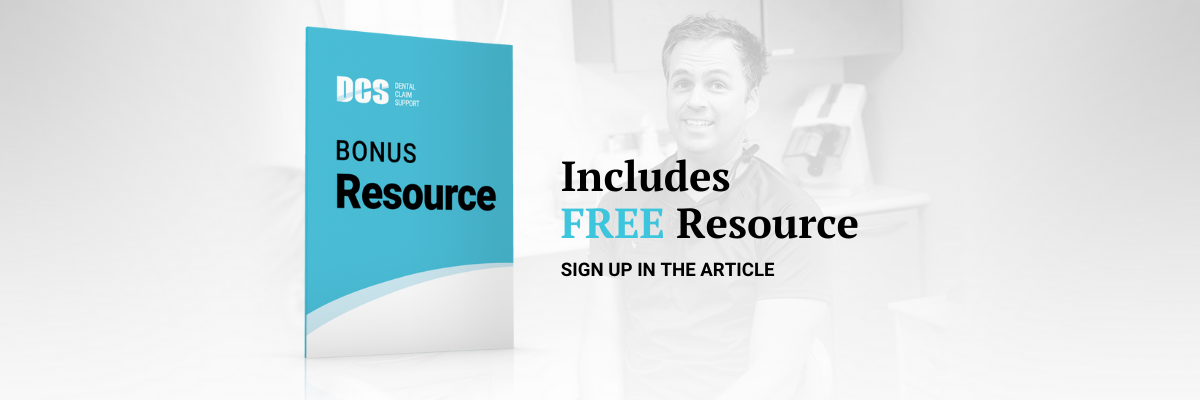What is dental billing? An understanding of how dental billing works


Dental billing sounds straightforward, but it is packed with pitfalls that can hurt your bottom line. Care and attention to the 8 essential steps in patient and insurance billing — combined with clear procedures, expert support, and automation — will maximize your dental business revenue.
Dental billing is any activity that collects payment for dental services performed in your dental practice. A dental billing payment comes in two forms: Insurance payment and/or patient payment.
Your dental billing process is your strategy for collecting from these two revenue sources. How efficiently and accurately your dental team moves through your dental billing process will affect several aspects of your dental business, most importantly, your bottom line.
You can better understand what your billing process needs for efficiency by downloading our free resource, Dental Revenue Cycle Best Practices Checklist. Fill out the form below to receive the checklist in your inbox within minutes.

When there are problems with your dental billing process, you’ll collect less than you’re owed, struggle under intermittent cash flow, and be more vulnerable to embezzlement — and even accidentally commit insurance fraud.
Key takeaways about dental billing:
- Dental billing includes collections from both insurance companies and patients.
- Flaws in paperwork, procedures, and the postal service complicate billing processes
- There are 7 essential steps for every treatment, from patient scheduling to patient collections.
- You can streamline and simplify billing with optimized procedures, trained experts, and automation.
Now let’s sketch out the dental billing process, so you can ensure yours is optimized for maximum collections and efficiency.
What is the dental billing process?
As we mentioned, the dental billing process contains the workflows used to collect from both insurance companies and patients.
Of course, it’s not always straightforward. There are a plethora of factors that impact how you collect revenue from your dental billing process. For example, you might have to take medical insurance into account when sending insurance claims, depending on the type of treatment performed.
And if you are a fee-for-service practice, you might not deal with insurance at all — just out-of-pocket patient payments.
If you zoom out from the dental billing process, you'll see the full dental revenue cycle, broken down into 7 steps:
- Patient scheduling
- Insurance verification
- Present treatment plan
- Send clean claim
- Insurance billing
- AR management
- Patient billing
But let’s get more specifically into steps #5 and #7: Your insurance billing and patient billing processes…
What is the dental insurance billing process?
The dental insurance billing process is how you create, submit, follow-up, and collect payment from insurance claims. Let’s lay out the steps of the insurance billing process:
- Create the insurance claim
- Include all the patient’s personal and insurance information (ideally, this is verified in advance of their treatment date).
- If the patient is covered by multiple insurance plans, create multiple claims using Coordination of Benefits (COB) rules.
- Include the proper CDT or CPT codes to justify the necessity of treatment.
- Accurately list the treating dentist.
- Attach relevant documentation (clinical notes, x-rays, intraoral photos, periodontal charts, narratives, primary Explanation of Benefits (EOB).
- Submit and track the insurance claim
- Submit the claim within 1 to 2 business days of the patient’s treatment — the sooner the better.
- Note when you submit the claim, and if it hasn’t been paid within 2 to 3 weeks, begin the appeal process.
- Follow-up — aka “Work” — the insurance aging report to appeal denied claims
- If a claim has been denied or not paid by insurance, follow up with the payer to determine why and resubmit a corrected or supplemented claim.
- Start with your oldest claims first, as their timely filing deadline will hit before newer claims.
- To expedite your follow-up calls, have each claim’s information in hand when you contact the insurance company for details needed for its appeal.
- Collect when your insurance claim payments post
- Post insurance claim payments to your practice management software (PMS).
The insurance billing process can get complicated with patients’ insurance changes, annual code updates, and especially when medical insurance is included. It’s crucial that an insurance billing expert is handling this part of your dental billing process (or revenue cycle), so that you collect all you’re owed as swiftly as possible and not leave your money in the hands of insurance companies.
What is the dental patient billing process?
The dental patient billing process has fewer steps than dental insurance billing, but it requires a lot more communication with your patient — and that in itself can get complicated. 
The most important aspects of your patient billing process are that it’s transparent, convenient, and makes it easy for patients to pay right away. Here are the steps:
- Communicate to your patient your practice’s payment policy.
- Explain that they are ultimately responsible for their full treatment fee, no matter how much their insurance pays.
- Present financial options, such as a payment plan and/or other payment options. This is best done during your pre-treatment presentation, which is Step #3 on the dental revenue cycle.
- Collect from your patient after insurance payment posts
- Generate a detailed billing statement for your records.
- Generate and send a detailed billing statement to the patient, so they see their bill in writing. This can be a mailed paper statement, but ideally, this process is fully automated.
- Send your patient payment reminders
- If the patient has an outstanding balance, deliver periodic reminders with opportunities to pay. Traditionally, reminders are sent by mail, but they can also be fully automated.
The challenge with patient billing is simple: The poorer a patient’s billing experience is, the more likely you are to lose their goodwill — and perhaps their business.
But when you make it easy for your patient to pay their balance, they are more likely to pay their bill ASAP without dispute, especially if they know ahead of time of what the amount is likely to be.
Here are a few valuable tips from our revenue cycle management experts on how to optimize your dental billing:
The consequences of broken dental billing processes are severe. Not only will you lose out on the consistent cash flow you need to run your business, but you’ll have a disorganized office, a stressed team, and deliver a poor patient experience.
You’ll also open yourself to embezzlement, and some insurance claim errors can be interpreted as insurance fraud, resulting in legal trouble for your business and even your patients.
Related: Where's the weak link in your dental revenue cycle?
So here are a few valuable tips from our revenue cycle management (RCM) experts to optimize your dental billing process:
- Create standard operating procedures to document each of your team’s processes, and regularly review, improve, and update these processes.
- For example, if you’re still sending out paper statements to patients, and they’re slow to pay (or don’t pay at all), switch to automated patient billing. It is a no-stress, high-impact improvement that your team and your patients will love. It utilizes email, text messages, and a website, so patients can conveniently pay online, which makes it a hands-free process for your staff.
- Ensure you have a designated insurance billing expert. Insurance billing is not something that can be learned on the job — it’s complex, and nuanced, and any mistakes are high stakes. Your insurance biller needs to be experienced, proficient, and consistent in the following areas:
- Coordination of Benefits (COB) rules
- Medicare rules
- How to calculate a patient’s payment responsibility
- Calculating write-offs and entering them correctly
- Documentation and attachment requirements for specific treatments
- How to appeal denied claims
- Latest coding updates
- Posting all payments promptly so your cash flow numbers are correct
- How to run reports that show where your billing processes need attention
- Automate where you can. Automation is a great way to reduce the time your team spends on tedious and repetitive tasks, so they can focus on other parts of growing your dental office and dialing up patient satisfaction.
- For example, you can completely automate your credentialing, scheduling, and patient billing processes with the DCS Expansion Pack. Learn more about automating these vital parts of your dental business here.
An efficient, modern dental billing process leads to higher revenue, consistent cash flow, a more productive staff, and happier patients. Not to mention, a stellar reputation for your dental business!
Get your Dental Revenue Cycle Checklist to track your billing processes
We’ve gone through both parts of your dental billing process, and now let’s talk about your overall revenue cycle.
It starts with your patient scheduling their appointment and ends with you collecting payment from both patients and insurance payers, with critical steps in between to fast-track those payments.
You can use our Dental Revenue Cycle Checklist to help track your processes and also spot weak links in your workflows. Fill out the form below to get the Dental Revenue Cycle Checklist in your inbox within minutes.

With our Dental Revenue Cycle Checklist, you’ll be able to define your standard operating procedures more clearly, track each step, and make adjustments when needed. You can print, bookmark, and save the Checklist for your use.
Cultivate a profitable dental billing process with our RCM experts on your team
To recap, the dental billing process is made up of your insurance billing and patient billing processes. These are your sources of revenue for your dental business, and each comes with its own unique challenges…
- Insurance billing is inherently complicated, and every year, insurance companies make it harder to receive reimbursements with your first claim submission.
- Patient billing is difficult in how you must be sensitive to your patients’ needs, expectations, and limitations, and also ensure their payment experience is clear and convenient.
Both can be skillfully managed with the help of revenue cycle management experts and a touch of today’s technology.
DCS offers end-to-end revenue cycle management solutions, including insurance billing and patient billing. Our experts will help your business make more money and empower your team to create a memorable, positive experience for your patients: Book a free 30-minute consultation today.
Related Posts
Dental revenue resources from Dental Claim Support

